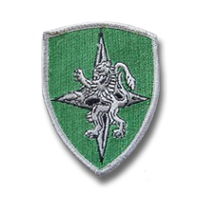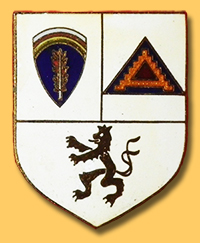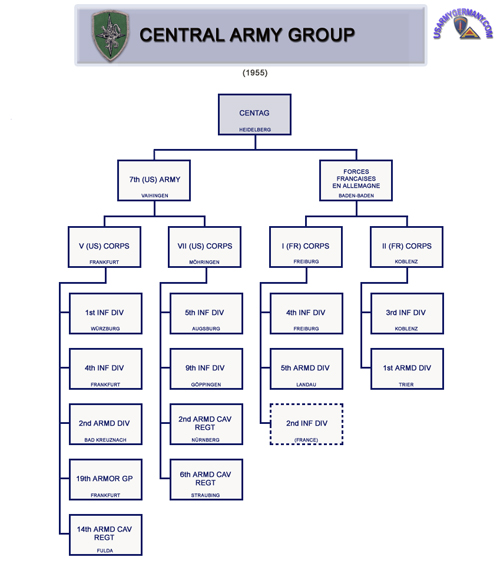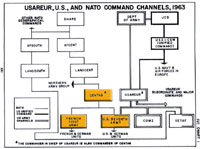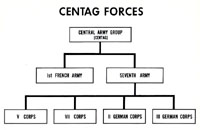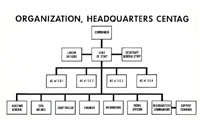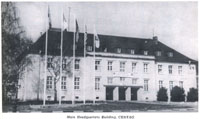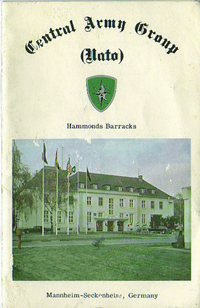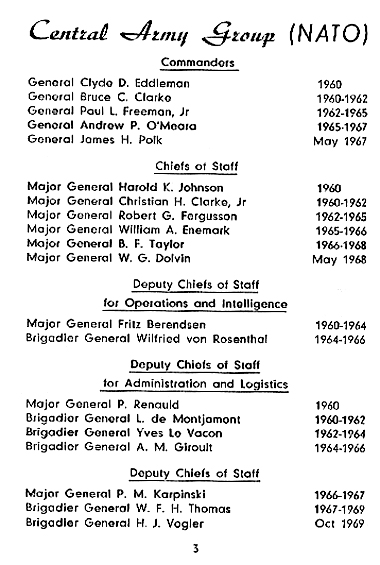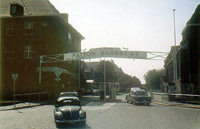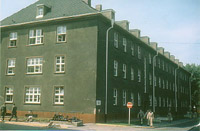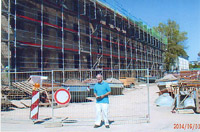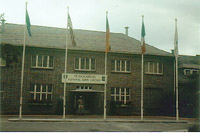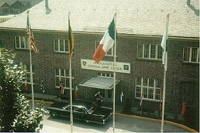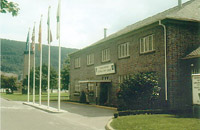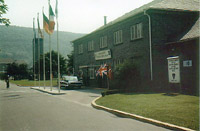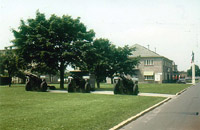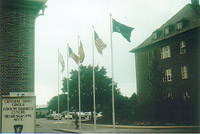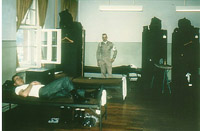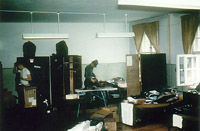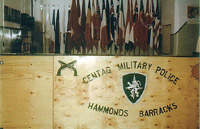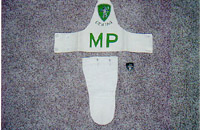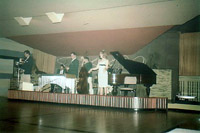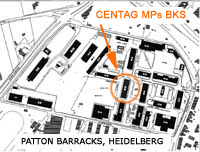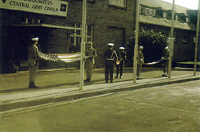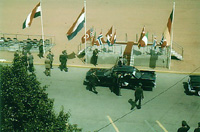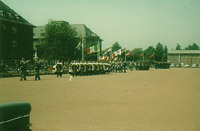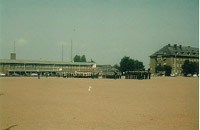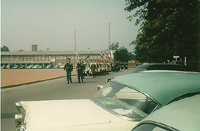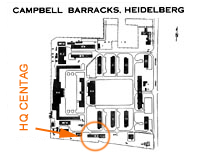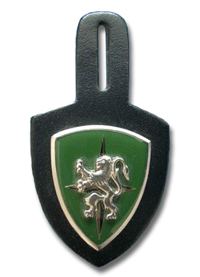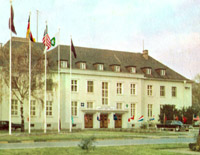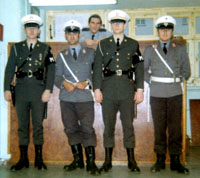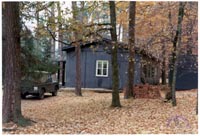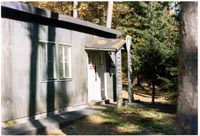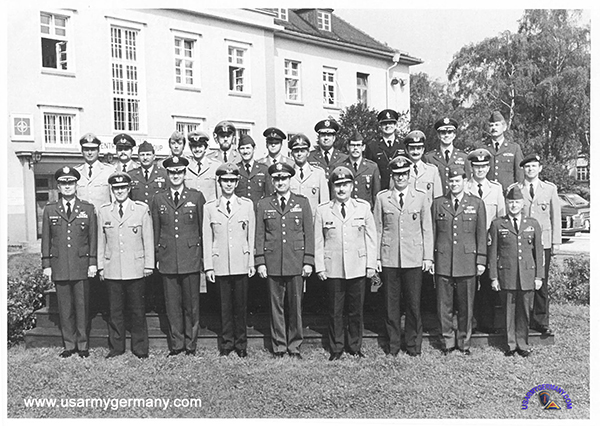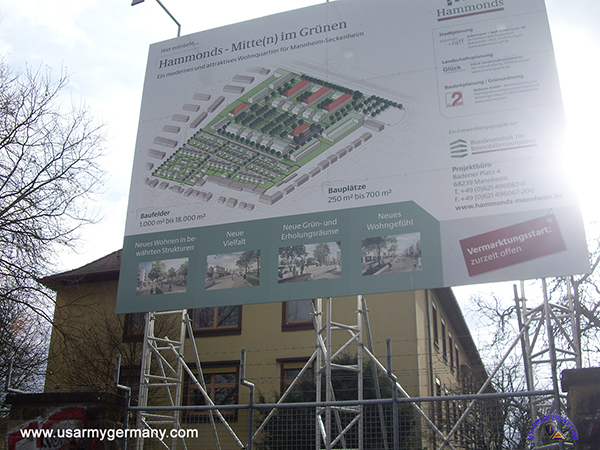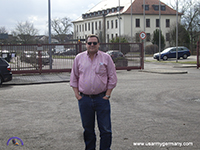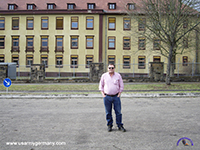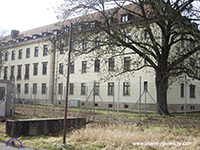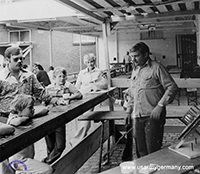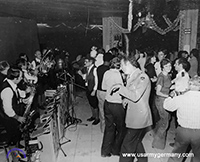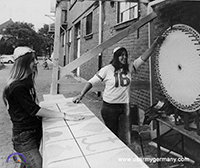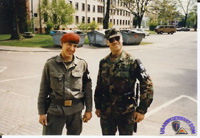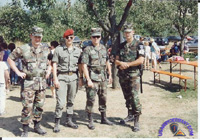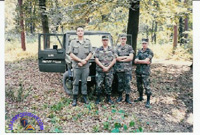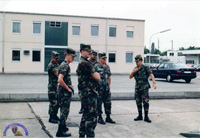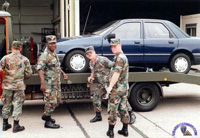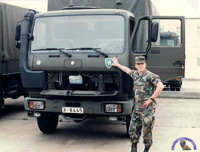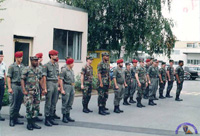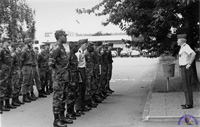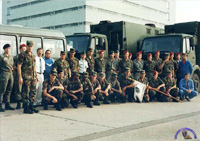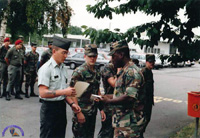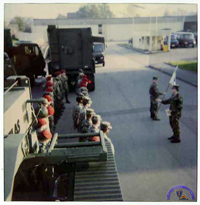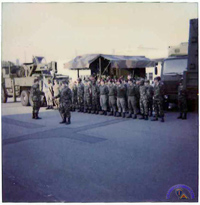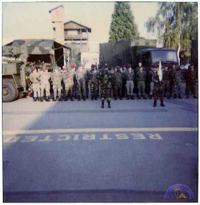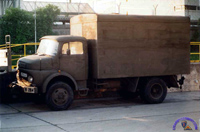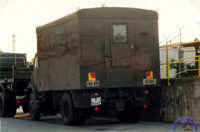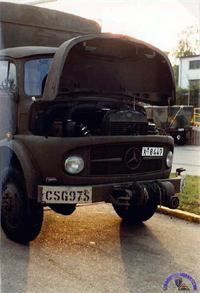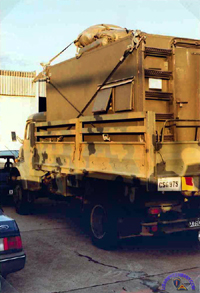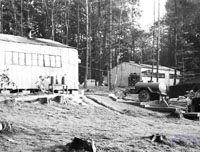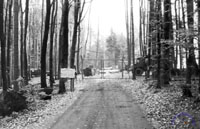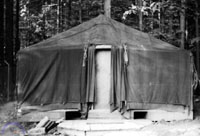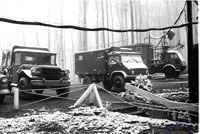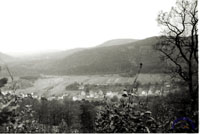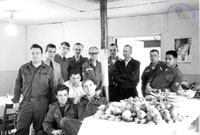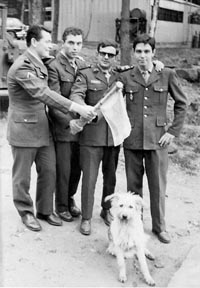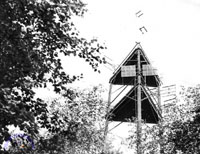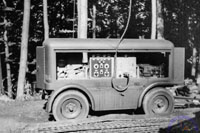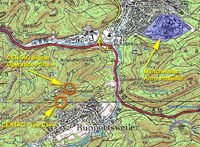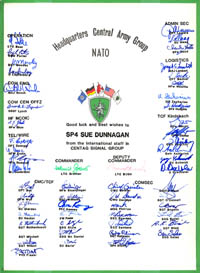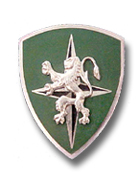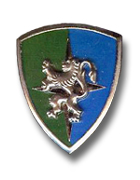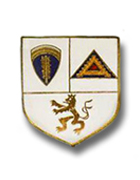| If you do
NOT see the Table of Contents frame to the left of this page, then
Click here to open 'USArmyGermany' frameset |
|||||||||||||||||||||
|
Central Army Group |
|||||||||||||||||||||
|
|
|||||||||||||||||||||
|
|||||||||||||||||||||
|
|
|||||||||||||||||||||
| History | |||||||||||||||||||||
|
|||||||||||||||||||||
| 1950 - 1993 | |||||||||||||||||||||
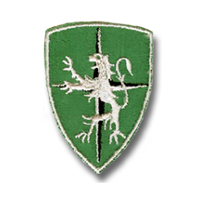 Early version of CENTAG patch Early version of CENTAG patch |
|||||||||||||||||||||
| (Source: Official NATO website) | |||||||||||||||||||||
Since 1952, NATO forces have been stationed in Heidelberg, Germany when the Central Army Group (CENTAG) plans staff began working at Campbell Barracks within the U.S. Army Europe staff. The activation of the German Bundeswehr in November 1955 resulted in the augmentation of the CENTAG plans staff with representatives from the German Army. The CENTAG plans staff then formed a separate headquarters in April 1959, comprising military personnel from Germany, France, and the United States. The Supreme Allied Commander, Europe formally activated CENTAG Headquarters on Oct. 1, 1960. (Webmaster note: I believe that Headquarters CENTAG was originally located at Patton Barracks.) Later, in August 1961, Headquarters CENTAG moved to Hammonds Barracks in Seckenheim, Germany. |
|||||||||||||||||||||
Corps sectors for CENTAG and NORTHAG, 1980s |
|||||||||||||||||||||
| (Source: Wikipedia - Command Component Land Heidelberg) | |||||||||||||||||||||
The Central Army Group (CENTAG) was established in 1952 and assigned to work with US Army Europe at Campbell Barracks, Heidelberg, Germany. When the Bundeswehr was activated in 1955, some German personnel were assigned to the plans section of CENTAG. Structural changes began in June 1993, when CENTAG and its counterpart in northern Germany, the Northern Army Group (NORTHAG), at Mönchengladbach, were deactivated and combined to form Allied Land Forces Central Europe (LANDCENT), which was activated in Heidelberg on 1 July 1993. |
|||||||||||||||||||||
| 1955 | |||||||||||||||||||||
| 1959 | |||||||||||||||||||||
| (Source: STARS & STRIPES, August 18, 1959) | |||||||||||||||||||||
| Headquarters Central Army Group (CENTAG) is located in Bldg 16, Campbell Barracks, Heidelberg. The headquarters moved to that building from Bldg 9 in February, 1959. The move was necessitated by the ongoing expansion of the headquarters staff to about 100 officers. (In 1958, headquarters comprised approximately 20 officers. At the time of this article the staff has a strength of about 50 officers.) Gen C. D. Eddleman, current CINCUSAREUR, is also the commander-in-chief of CENTAG. CENTAG is a three-nation (1) ground command that (along with its counterpart in northern German - NORTHAG) comes under the control of Allied Land Forces Central Europe. The mission of HQ CENTAG in peacetime is to serve as a planning group. It also supervises training during peacetime, especially exercises involing higher-level staffs. In wartime, the command would become operational and assume control of the US 7th Army, the French 1st Army, and two German corps. (1) US, France, Germany |
|||||||||||||||||||||
| 1960 | |||||||||||||||||||||
| (Source: STARS & STRIPES, Oct 2, 1960) | |||||||||||||||||||||
| On Oct 1, 1960 CENTAG became the newest member of the NATO military command. Central Army Group was originally organized as a planning staff within Headquarters, US Army, Europe. In December 1959, the command was established as a provisional headquarters and moved into its own buildings at Campbell Barracks, Seckenheim. In September 1960, the NATO Council of Ministers approved Central Army Group as a NATO military command. CENTAG, composed of troops from Germany, France and the US, is responsible for the ground defense of an area that extends from the borders of Austria and Switzerland north to an area just south of the Ruhr River. |
|||||||||||||||||||||
| (Source: STARS & STRIPES, Dec 19, 1960) | |||||||||||||||||||||
| The CENTAG HQ Support Command was formed on Oct 1, 1960 at Campbell Barracks, Heidelberg. The battalion-strength unit is commanded by Lt Col Robert M. Cook, US Army, and provides clerks, translators, drivers, motor pool mechanics, MPs and engineers for CENTAG HQ. The assigned personnel come from all three NATO nations who make up the Central Army Group: US, Germany and France. They live together, work together and play together as members of one of the most integrated units in all of NATO. (There are other integrated NATO units such as at Northern Army Group HQ and 4th Allied Tactical Air Force HQ.) They are assigned to three separate (national) companies: "A" Company is French (not yet at full strength), "B" Company is German and commanded by a German Captain and "C" Company is American with an American 1st Lieutenant as commander. The members of the three companies live in the same building and eat at an American mess hall. Eventually, the German and Fench soldiers will have their own messes. However, each company has its own supply and arms room. English and French are the official languages of the headqaurters and all official papers are translated into both languages by the Translation Section. However, a lot of the day-to-day work is primarily done German. The unit's soldiers get four hours of language classwork a week - in German and English. French will be added later. CENTAG headquarters is colocated with USAREUR headquarters at Campbell Barracks. One of the three gates at the kaserne is a CENTAG gate, manned by Support Command MPs. The 529th MP Company, a USAREUR unit, mans the other two gates. |
|||||||||||||||||||||
| (Source: Report of Stewardship, Oct 1960 - April 1962, Gen Bruce C. Clarke, HQ USAREUR, 1962) | |||||||||||||||||||||
| CENTRAL ARMY GROUP |
|||||||||||||||||||||
|
|||||||||||||||||||||
| 1963 | |||||||||||||||||||||
| (Source: STARS & STRIPES, May 1963) | |||||||||||||||||||||
| Click here for an article on a special mobile photo lab operated by the 516th Sig Gp during Grand Slam II. | |||||||||||||||||||||
| (Source: STARS & STRIPES, May 1963) | |||||||||||||||||||||
| Grand Slam II Ends; Joint Test Successful SECKENHEIM, Germany (Special) -- Grand Slam II, an annual joint Central Army Group-4th Allied Tactical Air Force command post exercise, which began May 2, closed Tuesday. Grand Slam II involved combat and combat support headquarters elements of the German, French and U.S. forces assigned to CENTAG, commanded by Gen Paul L. Freeman Jr. There was no significant movement of troops during the exercise, CENTAG and 4th ATAF Hq at Ramstein Air Base said in a joint announcement. The 4th ATAF, under command of Gen Truman H. Landon, took part in the exercise with Canadian, United States, French and German air units attached. Aircraft of the four nations flew extensive sorties during the exercise, the announcement said. Grand Slam II was one of the normal, routine NATO training exercises conducted jointly by CENTAG and 4th ATAF. Its purpose was to test the plan, procedures and coordination of the forces assigned to the two NATO commands. Top officers of both CENTAG and 4th ATAF agreed that "the objectives of the exercise were successfully accomplished," the announcement concluded. Grand Slam II, second in a series, attracted many distinguished military visitors from several of the 15 NATO nations to different field headquarters, including Gen Lyman L. Lemnitzer, Supreme Allied Commander, Europe. |
|||||||||||||||||||||
| Late 1963 | |||||||||||||||||||||
| (Source: Central Army Group (NATO), Hammonds Barracks - booklet issued by CENTAG late 1960s) | |||||||||||||||||||||
|
|||||||||||||||||||||
|
|||||||||||||||||||||
| On 30 June 1993 CENTAG and 4ATAF discontinued operations. | |||||||||||||||||||||
| CENTAG Support Command | |||||||||||||||||||||
| Early 1960s | |||||||||||||||||||||
| (Source: Robert Bertelson) | |||||||||||||||||||||
| I'll be glad to try to recall some of my memories of those days. After MP school at Ft. Gordon, I was with the 546th MP Co at Ft. Sill, Oklahoma for all of 1960. In December 1960 I received orders to report to Ft. Dix, NJ for reassignment to Europe. There, as everyone was being lined up to be individually assigned a destination (we had no idea of where at that time), I was interviewed by a Sergeant who said that he had ONE special assignment to fill - that he didn't have any information about what the job was but that it was something special in Germany. All he knew was that it was something very special and that because I had scored highly on several of my Army tests and that I had an AA degree that I would qualify. He thought it was something secret and that I would be working somewhere around some sort of Headquarters but that was all the information that he had. It sounded sort of intriguing but the real clincher was that he said if I was interested, he would FLY me to Germany that afternoon. I had been listening to everyone's stories about the horrors of the upcoming ship transport to Europe where I would be throwing up, etc for over a week, so I said yes, and sure enough, I was flown in a military plane with a bunch of high ranking officers to Frankfurt that very afternoon. There, a soldier from Patton Barracks in Heidelberg picked me up in the company commander's car and drove me to Patton Barracks. Enroute, I asked him about the MP assignment that I would be going to. He said that nobody really knew very much about the MP group, that they did something sort of special or secret and that they didn't have any real association (militarily) with anyone else at Patton Barracks. After reporting in at Headquarters, I was taken to our three story barracks. I learned that our group consisted of 11 French, 11 German, and 11 American MPs. The French lived on the third floor, the Germans on the second floor and the Americans on the ground floor. Much to my delight and amazement, I learned that we didn't have to stand any formations, etc, and that our only functions were to raise and lower the various flags at CENTAG Headquarters located at Campbell Barracks, just a few miles away. Once a month, there would be a practice alert (usually in the middle of the night) and we would all go to the Headquarters building and set up security for the building and for the "War Room", located in the basement. This was where the Generals would go to conduct their operations in the event of war with the Russians, which in those days, didn't seem too impossible. We each had our own Generals to act as bodyguards for - we had General Clark, the Germans had General Berendsen, and the French had General Mogemot. In many ways, this was a dream assignment and probably the only one like it in the Army. We had a Lt. from the Headquarters Co. who stuck his head into our barracks about once a month to ask if we needed anything, other than that, it was like being a civilian. We were "supervised" by a corporal who made out the work schedule. I don't think we worked more than about thirty hours a week; the rest of the time we were free to do anything or go anywhere we wanted. I remember that we all had NATO Secret security status, but other than having access to the War Room, we were essentially body and building guards. As a Headquarters, there were often ceremonies involving high ranking NATO officers. I have many pictures of some of these - the Americans in dress blues, the Germans in their dress greys, and the French wearing a dress uniform with a white cape. The CENTAG MP's never took part in these, (I didn't even have dress blues), these cememonies were handled by the American MP's that were stationed at Campbell Barracks. Those were very idyllic times, Heidelberg was a relatively small town compared to what it is today, I was in the Army, but it was almost like I was a part time civilian worker barely associated with the military. In the summer of 1961, I took a three day pass to visit Berlin and, as fate would have it, was in West Berlin in the morning, and in East Berlin on a tour bus in the afternoon of the day the Russians started to put up the Berlin Wall. I was chased back across the border by a East Berlin guard with a sub machine gun after I tried to take a picture of his building near the Brandenburg Gate. I of course had no idea of the bigger picture of what was going on at that time. When I got back to Patton Barracks, my fellow MP's were at the War Room and some of us were sitting on tanks in a nearby field waiting for the Russians. After just a day or two, things settled down and we returned to our regular routine just as if nothing had happened. Shortly thereafter, we were relocated to Hammonds Barracks in nearby Seckenheim, but still commuted by German truck to Campbell Barracks to do our routine flag raising and building guarding duties. At Hammonds Barracks, we had a desk in a building adjacent to the main gate where we did security. We still had no real military structure and lots of time off. I think the reason things were as they were was because the 11 of us always acted responsiibily, got the "job" done and didn't really require any supervision or discipline. It was probably the only outfit in the Army where a SP4 got to know a Major General practically on a first name basis. I stayed at Hammonds Barracks until November of 1961 when I returned home on emergency leave when my father died suddenly. It was near the end of my enlistment and I was reassigned to Ft. McArthur to take care of my ailing mother until I was discharged. The only names and home towns of my fellow MPs that I remember are Nick Agosta, Don Ross, Denny Brierton, Don Stebbins, last name Pruitt, a guy from near New Orleans, one from an island near Seattle, Phil Marcus, and a few more that I can't remember right this minute. We were very friendly on and off duty with the German MPs (all of whom spoke english) but had nothing to do with the French MPs, none of whom spoke english, and acted very stand-offish. One of my friends, a German MP, helped me buy a car and I had lots of time to drive around central Germany. Two years ago, I took my wife to Germany to show her where I had been stationed. I has very disappointed when the civilian German guard at Hammonds Barracks wouldn't allow us any entry for a quick look and even threatened us with arrest if I took any pictures, even of the Hammonds Barracks sign at the gate. I was also disappointed that we could not gain entry into Campbell Barracks at all so that I could at least see the outside of the old CENTAG Command Building. I did get into Patton Barracks only to observe that my old three story barracks was in the process of being completely rebuilt and was nearly in shambles. The identical barracks on either side of the MP barracks were untouched. Very sad, but the rest of the trip was wonderful except to discover that Heidleberg is now a modern city with ugly high rise buildings and that the Hauptstrasse in now a shopping mall with Pizza Huts, etc. I'll always remember my CENTAG MP days fondly. ADDITIONAL INFORMATION: I didn't realize that CENTAG had only been formed a couple of months before I got there, I just assumed that it had been there forever and don't ever remember asking anyone how long that they had been there. Unfortunately, I haven't had any contact with any of my buddies since I left, probably because I left so suddenly because of my father's death, I didn't have time for any farewells or exchanging of home addresses. After I learned that I wouldn't be returning because of my mother's health, I sent one of my buddies a power of attorney and he sold my car and packed up all of my personal stuff from my wall locker and mailed it to me. I would love to be able to get in touch with a couple of guys that I was particularly close to, but I've never seen any info about anyone with the CENTAG MPs until you. Speaking of beer, I'm not much of a beer drinker but I did always have a beer with lunch or dinner at gasthauses in the Heidelberg area along with my wonderful german sausages. I remember the brand was "Schlossquell" and it was very mild and delicious. Two years ago when I took my wife to Heidelberg for my first return since 1961, I tried to order Schlossquell at dinner in Mannheim. The waitress explained that Schlossquell was a Heidelberg beer and that you could only get it in Heidelberg and sure enough during dinner our last night before leaving, I had a bottle at Perkeo's restaurant on the Hauptstrasse. I've regretted not bringing the empty bottle back with me. After I wrote to you, I got out my old photos and they brought to mind a few items that I didn't mention in my letter. The CENTAG MP barracks at Patton Barracks was building 114. The Headquarters building for CENTAG at Campbell Barracks was building 16, located on the south side of the parade field. One thing I didn't make clear in my letter was that in addition to the daily flag raising and lowering ceremonies, one CENTAG MP remained at the entrance of the Headquarters building all day (Mon - Fri) until the flag lowering at 5 PM. As I recall, those were about 2 hour shifts, but with 33 of us (11 American, 11 German, and 11 French) to split it up, we only averaged about a 2 hour shift about once a week or so. We were supposed to stand at parade rest, look sharp, and salute any officers that entered the building (which wasn't very often). I do remember one glitch - many of my fellow Americans didn't like or outright refused to salute some of the German officers that wore Nazi decorations on their uniforms that they had received for, frankly, killing Americans just 15 years earlier. Most of these German officers understood the situation and when they didn't receive a salute, they just ignored it rather than making an issue of it, but I do recall that in one instance, we were told that a German officer had complained about it and that we were told to start saluting them, regardless of any decorations that they wore. I also remembered that we wore white MP brassards with the CENTAG crest and "MP" in green and wondered if they were still worn when you were there. I still have mine along with the metal CENTAG crest badge that we wore on our left breast. In checking the website that you mentioned, the correct names and spelling of the three officers that we were to individually protect in the event of war were: I remember Gen Clarke as a friendly guy that sometimes would stop and chat with me at the door, calling me by name. |
|||||||||||||||||||||
| (Source: Email from Bob Chapman, 84th Trans Trk Co and CENTAG, 1960-62) | |||||||||||||||||||||
| Hi, I was stationed with the 84th Trans Truck Company at Patton Barracks in 1960. This unit was made a part of CENTAG in 1961 and we moved to Hammond Barracks. In late 1961 or early 1962, I was sent to Angevillers as part of a CENTAG detachment (from Hq & Hq Co. CENTAG), 7 of us -- five Military Police, one Cook (me), and one driver. I was the highest ranking soldier there, I was a Sp4. We stayed that way for a year, then I left and they sent a M/sgt Wolf to take over. We were given an old barracks in the far corner of the French compound, and our sole function was to guard CENTAG communications assets. We lived in Angevillers, drew supplies from Metz, and avoided Thionville for at that time there was much trouble with the Algerian population. We all carried our weapons anytime we left the compound, even off duty in restaurants & bars. Carrying weapons lasted about seven weeks. We spent most of our off duty time in Luxemburg and I would wind up marrying a young lady from Trier, Germany, who was working in Luxemburg. I retired from the service in 1979, and from all work in 2003. When I retired in 2003, I moved to Florida and one day while playing golf with a stranger, we found we were both at Angevillers, doing the same job. He arrived there one month after I left and went back to Germany. What are the chances? Went back to Germany in 1966 and wound up stationed at Neureut Kaserne with the 516th Signal Group which was part of STRATCOM. While serving with the 516th, we went on maneuvers both at the Angevillers and the Pirmasens bunkers. I ran one of the consolidated dining facilities as a SSG, got promoted to SFC and off to Viet Nam in 1968. (I believe I was initially with the 72d Signal Bn, part of the 516th.) |
|||||||||||||||||||||
| (Source: Email from Fred Wagner, 1st BG, 30th Inf & Trans Office, HQ CENTAG, 1962-65) | |||||||||||||||||||||
| I was commissioned a second lieutenant in the Regular Army in June 1962 out of the Georgetown University ROTC program. I had a two-year commitment in the infantry and after the basic course and airborne school, ranger school, I was sent to Europe where I found myself as a platoon leader in the 1st Battle Group, 30th Infantry, 3rd Infantry Division. That was William E. DePuy’s old outfit and the small unit training we underwent was considerably different than that taught at the Infantry School in Fort Benning, GA. When the army reorganized into the battalion/ brigade concept, I was transferred into Company A, 1 st Battalion, 30 th Infantry, and found myself serving under another future four-star general, George A. Joulwan (Joulwan and I became fairly close in those days and wound up serving under Depuy once again, this time—1966-1967— when he was the CG of the 1 st Infantry Division in Vietnam). When my two-year commitment in the infantry was up and I was to be transferred into my basic branch (the Transportation Corps), I found myself unassigned and hanging around battalion headquarters. I applied for and was accepted into the Special Warfare Psychological Operations Course, but before I could complete all three schools, I was told to report to Mannheim-Seckenheim for an interview as the Transportation Officer at the headquarters of NATO’s Central Army Group (CENTAG). I reported to the Support Command’s commanding officer—Lieutenant Colonel Maurice Melborne Bloom—and was told I would be competing with other officers for the coveted position. I had to go back for a second interview and at that time was told I was one of two candidates remaining for the position (the irony was that the other lieutenant was a Georgetown classmate of mine). Shortly after the second interview I was informed by the infantry battalion’s S-1, that I had been accepted for the CENTAG job and was to report immediately to Hammonds Barracks, Seckenheim. Once there, I was introduced to my immediate boss, the Support Command S-4, a Major Tecco (I have forgotten his first name). I also met the man I was replacing, First Lieutenant Richard Lohr. Lohr was sent Stateside about two weeks later and I settled in to my new job in June, 1964. I was probably the junior commissioned U.S. officer on post, there being only one other U.S. first lieutenant, the MP commander. He and I both drew troops from all three companies of the Support Command, French (from Company A), German (from Company B, commanded by a World War II German Army veteran, Hauptmann Weber), and American (Company C). The kaserne (Hammonds Barracks) also housed the ACE Mobile Force (consisting of U.S., German, English, French, Italian, and, I believe, Norwegian troops), but we seldom interacted with them. I seem to remember we had three American captains on post and the five of us were the only company grade Americans in Hammonds Barracks, everyone else being field grade or higher. The CENTAG Chief of Staff (and senior officer at Hammonds) was an American officer, Major General Robert Fergusson. His immediate superior was the USAREUR CG, General Paul Freeman, though Freeman was stationed in Heidelberg, several miles away. There were also two other flag rank officers on post, a German brigadier general named von Rosenthal (O&I) and a French brigadier general named Giroult (A&L). (I do not recall for certain whether we had a G-staff or a J-staff, but I am virtually positive we went as far as a “5” [Civil Affairs].) In addition to being the Army Group Transportation Officer, I was in charge of the motor pool. I cannot remember the precise number of men who reported to me, but there were soldiers from all three countries: the U.S., Germany, and France. (This was when France was still a military member of NATO.) An NCO commanded my German contingent, and the French troops were commanded by a warrant officer (“adjudant” or “adjudant-chef”) named Jean-Pierre Roger (a veteran of both Vietnam and the French war in Algeria). In addition to Roget, I had two American warrant officers, CWO Pauley and CWO Richard Soos. I also had a clerk reporting to me, a German civilian employee named Günther Lorke, who prepared all the necessary travel and transportation documents for staff officers—all nationalities, both CENTAG and ACE headquarters—when they had to travel. Unfortunately—and to my great regret—I remember only a few of the names of my troopers: a SP4 Jack Titter; another named Boss (from the Chicago area; I remember he bought himself a beautiful BMW motorcycle while he was stationed there), and another spec-four named Clemens. I also had a young U.S. sergeant whose name escapes me, but who was married and had a baby son. All—and there were probably more than thirty or forty men from the three companies who reported to me—were fine soldiers. |
|||||||||||||||||||||
|
|||||||||||||||||||||
| (I would also like to know if anyone could help me locate one of the metal CENTAG crests we wore on the upper left pocket of our Class A’s. I would certainly be willing to buy one.) I wound up spending ten years in the military, but because of personal family problems, had to resign from the Regular Army. Looking back on things, it was a decision I regret to this day. I spent a few more years in the military in the New York Army National Guard, but it was not the same, and after ten years, total, I left the service behind. From a platoon leader in a frontline infantry battalion in Germany, to the prestige of the job at CENTAG, as the commander of the army’s last boat company (in Fort Eustis, Virginia), to being the commanding officer of the 1 st Infantry Division’s (the Big Red One) only truck company (in Vietnam), to running convoys up and down routes 1 and 13 (Thunder Road), and to running the first “infiltration” convoys of the Vietnam War (to An Loc and the old Michelin rubber plantation), I had a short, sharp, and fine career in the service. I will always miss the men the most. |
|||||||||||||||||||||
| 1966 | |||||||||||||||||||||
| (Source: Emails from Dick Bleyenberg, Company B, CENTAG, 1966-68) | |||||||||||||||||||||
| It was back in 1966 that I received my orders for CENTAG, Company B. When I arrived, I found that Company B's barracks were part of a hospital complex in Münchweiler. CENTAG, Company A was located in Mannheim. CENTAG was a multi-national affair with American and German troops working side by side. Previously, French troops were also a part of CENTAG, but France pulled out of NATO and thus ended their involvement with CENTAG. After processing in, I was assigned to a squad whose duties were working in the Comm. Center in a concrete bunker located in Ruppertsweiler approx 15 or so minutes from Münchweiler. This bunker, also known as "The Cave" contained the Comm Center. These were pre-satellite days and all the incoming and out going traffic was by punched tape. The teletype machines, code machines, and printers all seemed to be WWII vintage. The Comm. Center was a 24/7/365 operation. Squads worked in rotating shifts. One week you worked days, the next week was the swing shift, next was a week of nights, and then a week called detail week which would be a day shift performing duties in and around the company area (non-Comm. Center work). I rotated back to the States early 1968. I understand the hospital where Company B was housed in Münchweiler is no longer there. The entire post was sold to developers and they demolished everything and planed to built a housing development in its place. The Cave also has been destroyed from what I can learn. CENTAG also has been integrated into some other unit I have learned. |
|||||||||||||||||||||
| Late 1960s | |||||||||||||||||||||
| (Source: SSG. Patrick Moore, SGT. John O’Connor, and SPC Phillip Ernstmeyer) | |||||||||||||||||||||
| The CENTAG MPs, we were told, started as a detachment from the 529th MP Corps Honor Guards from Patton Barracks in Heidelberg. We are assuming this took place in the early 1960s when the Headquarters was relocated to Hammonds Barracks. Their duty was serving all CENTAG related groups with military law, security, and the first line of defense. Our tour of duty for the following information was from 1968 to 1971 as CENTAG NATO MP. During this time the MPs were 50% American and 50% German Feldjagers IV Corps. Besides normal MP duties we were also responsible for security at the Our MP Station was located in Hammonds Barracks across the street from the Headquarters building. We provided a Desk MP at four different buildings at the Kaserne. One Desk MP was for the Headquarters that housed ranking NATO Officers, “Generals” (American, German, English, Canadian, and French). This building also contained the NATO Conference Room with translating head sets for all NATO Officers and Government personnel attending. We checked everyone in and out, and were physically posted in the conference room during breaks and meals. There were two other buildings with a Desk MP that housed the NATO Military and civilian personnel connected to G-2, G-3, and other services related to the Central Army Group. Some of these offices were behind very secure doors, a most restricted area. All CENTAG NATO MPs had a top secret clearance for this tour of duty. The fourth building was the Officer’s Club. This site was used for lunches, dinners, and some very large parties for visiting military and government dignitaries. The Officers Club as the Headquarters Building was decorated with collectable prints, crystal chandeliers, and antique furniture from all the NATO Countries. Duty for these areas required a clean shave, whitewalls, a wrinkle free pressed uniform, and spit-shined boots. At Feudenheim Bunker ( At Ruppertsweiler Bunker ( There were five MPs stationed at this site, two Germans, two Americans, and one German or American sergeant. The MPs lived at the site; it had an outhouse and was oil-heated, but had no running water. Trips to the Pirmasens Hospital (Husterhoeh Kaserne) were made about every other day for showers, C-rations, and other supplies. Duty there was simple: keep the MP area secure , simulate Hill 450, and have a good relationship with the village citizens. To the town’s people we were known as the Ruppertsweiler MPs, and they used us when there was a problem related to military personnel. |
|||||||||||||||||||||
I'm attaching some photos; the one with five of us at the desk, the four standing, we all stay in touch with each other to this day.
|
|||||||||||||||||||||
|
|||||||||||||||||||||
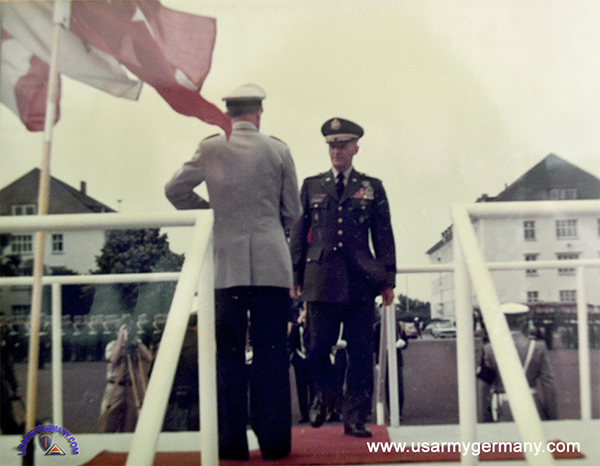 General Blanchard, coming up onto the stage, is greeted by Gen Renner. In the background is Bldg 970 (on the left) and 968 on the right (James Savage) |
|||||||||||||||||||||
| 1976 | |||||||||||||||||||||
| (Source: Email from James Savage, US Army Element, CENTAG, 1976-78) | |||||||||||||||||||||
| I came down on orders for a “Special Assignment” around May 1976. At the time, I was a PFC with about one-year time in service. Dependent upon completion of a Background Investigation for a security clearance, I was heading to HQ US Army element CENTAG. My report date was in late Oct 1976. My background investigation was completed without any issues and a security clearance was issued. Got my orders and flew on a Military Airlift Command Charter flight from McGuire AFB, NJ to Rhine Main AB, Germany. Arrived at the 21st Replacement Co (REPO DEPO), where I spent two uneventful days and nights filling out paperwork and just sitting around waiting for transportation to my “permanent” assignment. Someone from CENTAG showed up in a NATO tagged vehicle and drove me to my new posting. I felt pretty lucky because most other folks were loaded onto buses and shipped out in groups of 50 or so. When I got to CENTAG and completed in processing, I was assigned to the G2 Section. I was a clerk typist – 71B20, who worked directly for SFC David GOWEN and the ACOS, COL Benjamin Hamilton. They treated me like their son. Our duty day was Monday to Friday, about 0800 to 1600. Because we were a NATO unit, we got every NATO country’s holidays off from work; it was great, we got at least two extra days off from work every month – Portugal Independence Day, we were off; Belgium King’s birthday, we got the day off. Germany has at least two holidays per month – some religious and some just because it’s getting close to something religious. My living arrangement was in a large room on the 3rd floor of the US Barracks, Bldg. 972. I shared this room with three others – each of us lived in a corner of the room, with a living room/couch and coffee table in the center. No need to have a TV because reception was lousy, AFN was in black and white and stopped broadcasting at about 2300. We could not get nor could we understand the German television. The only roommate I can recall is SP4 Tom Wagner from Denton, TX. He was a driver in the motor pool and was the person who picked me up from the 21st Replacement Company I forget our unit commanders name – she was a US Army Captain, and although she was very nice and did not present any challenges, I had little interaction with her. Our main concern was not the US Army business but the mission we were conducting at our daily duty stations. We had very few room inspections or unit formations. By and large, everyone picked up after ourselves, we mopped the hallways and cleaned the common bathrooms on a short duty rooster on each floor. Our 1SG was probably one of the best I had over 25 years’ service. His name was Herbert Bell, and in 1976 he probably had 20+ years’ service. He and everyone else was a pretty regular drinker; he didn’t get excited about anything. He spoke and understood the German language and made damn sure I attended the mandatory Head Start Language classes. He was really a decent guy and I’ll never forget when I had to go home on emergency leave, he squared away everything, tickets paperwork etc, and as I was walking out the door to go to the airport he asked how much money I had on me. I had maybe $50.00, and he reached in his pocket and gave me the bills he had – perhaps another $80.00 or so. I’ll never forget this and during my career when I had the chance, I did the same thing to subordinates who were going to be traveling on a moment’s notice. I became close to SGT Donna Markel, who lived on the first floor of the US Barracks and worked in the G5 section. She had a POV and was interested in traveling whenever she could. None of us had any passports at this time, but we were able to use DA Form 31’s (Leave and Pass Requests) instead of a passport. This was decades before the European Union, so we stopped at each national border and showed our DA Form 31 and military ID and were allowed to pass. I think it helped that we were operating a vehicle with USAREUR plates. During my almost two years at CENTAG we made individual trips to Venice, Italy; Salzburg, Austria; Paris, France and Copenhagen Denmark. We also made weekend expeditions to Munich, Nuremberg and Wurzburg Germany. We also participated in military exercises two times per year – these required us to go to a tactical headquarters located along the West German/France border for about two weeks at a time. At the conclusion of these exercises a group of us would jump in the car and drive to Nancy, Metz or Lyon France. One final benefit of a NATO assignment was that we were issued French and Canadian PX entry cards. On more than one occasion, we would drive to Lahr to visit the Canadian outlet or Speyer to the French outlet to get bottles of wine (without labels) and great cheese. I could continue on for pages – but you get the idea – at the time, this was a fantastic assignment that truly molded me and convinced me to stay in the Army and make a career – it was fun if you made it fun, and you got to meet and work with some very interesting folks. In addition to the folks identified in the official G2 photograph – here are the names of some of the folks who lived in the barracks with whom I shared a lot of laughs and beers: SP4 Phil Lamonico, SP4 Paul Bull, SSG Steve Bradford, PFC Lew Patterson, SPT Manny Galino, SP4 John Bean (Com section in attic) Sp4 Taylor Bass, SGT John Morris, SP4 John Butler, XXX Penny Beal. |
|||||||||||||||||||||
|
|||||||||||||||||||||
| 1990 | |||||||||||||||||||||
| (Source: Email from Matthew Schwalm, NATO Combined Military Police CENTAG, 1990-93) | |||||||||||||||||||||
| I enjoyed you site on CENTAG, Campbell and Patton Barracks. I was an MP assigned to CENTAG from 1990-1993, it was a wonderful trip down memory lane. Thanks again. NCMP was an international military police organization. We had a German Hauptmann who commanded the company and an American NCO as the NCOIC. We were responsible with security for the NATO Bldgs within Campbell Barracks, various patrol duties at the Joint Support Group bldgs adj to Patton Barracks and the Motor Pool at Friedrichsfeld. We also provided security at the IOR (International Other Ranks Club) at Patton Barracks. It was interesting and fun working with the German soldiers, and was a far cry form my first active assignment as a division MP with the 10th Mountain Division (very little law enforcement -- we were in the field as much as the infantry -- that was a lot of fun). NCMP was based out of Bldg 7 which is the main bldg one drives under as they come through the main gate. I miss Heidelberg a lot and hopefully will return for a visit someday. It is one of the most beautiful cities in all of Europe. Here are some pics from Heidelberg that I took back in the early 1990s. The first is of Kokot (Gefreiter in the German Army), and Spc Kevin Lindsey of Alabama. They were both in my platoon. In the background is Bldg 8 -- 4ATAF. The second is of the CENTAG annual picnic, somewhere outside Heidelberg. We provided security. L to R: Sgt. John Pekar of MD, Uffz Alex Goerner, Sgt Dan Holcombe, and me, Spc Matthew Schwalm (all from my platoon). I just returned from PLDC (NCO school at Graf -- I received my stripes the following May.) The third photo is somewhere outside Heidelberg. We had just received these brand new Mercedes Jeeps. L to R: Stuffz Patrick Zoller of Bavaria, Sgt Craig Finley of NC, Spc Schwalm (me)., and Spc Dan Holcombe of CA (all from my platoon). Zoller was very tall. I am six ft and he towered over me. |
|||||||||||||||||||||
|
|||||||||||||||||||||
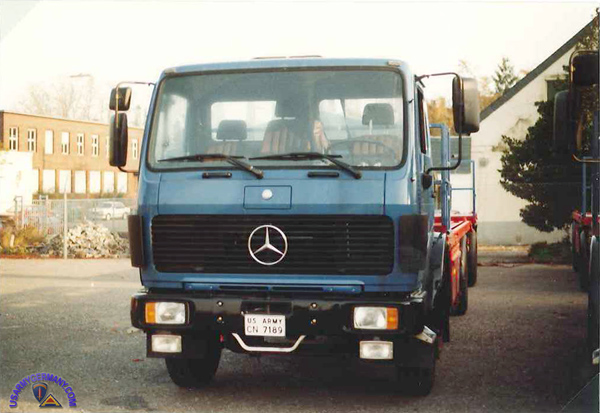 Mercedes trucks purchased by USAREUR c. 1990 (Benno Knorr) |
|||||||||||||||||||||
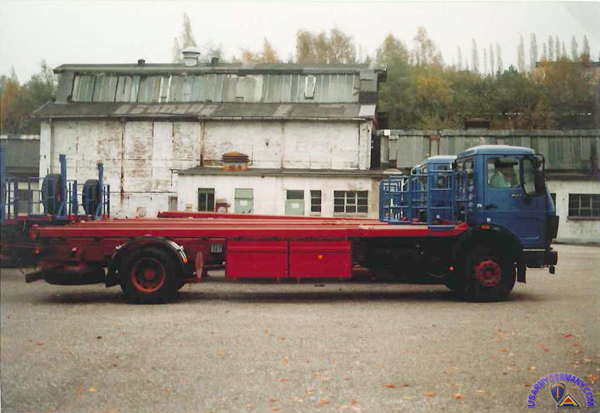 Side view of Mercedes trucks (Benno Knorr) |
|||||||||||||||||||||
| (Source: Email from Benno Knorr, retired member of SHAPE and CENTAG headquarters) | |||||||||||||||||||||
| CONGRATULATIONS for your absolutely great US ARMY GERMANY website !!! Even for an NATO insider, there are always new details never seen or heared before!
Enclosed are a couple of scanned pictures of US ARMY truck/trailer combinations. These trucks were build by ACKERMANN Co of Wuppertal on MERCEDES chassis. The trucks and trailers were flatbeds, ready to be loaded with a container type shelter (note the x-long wheelbase). They were to be delivered to a USAREUR unit (don't know which one) in Heidelberg. This unknown unit moved to Baumholder around 1991). The unit was waiting for the shelters to be loaded on the trucks and trailers. The trucks were parked at Campbell Bks./Heidelberg but I have never saw them with the shelters loaded. We never got any information about the use of the trucks. Maybe USAREUR was planning an "alternate mobile HQ" like ours at CENTAG / 4ATAF? |
|||||||||||||||||||||
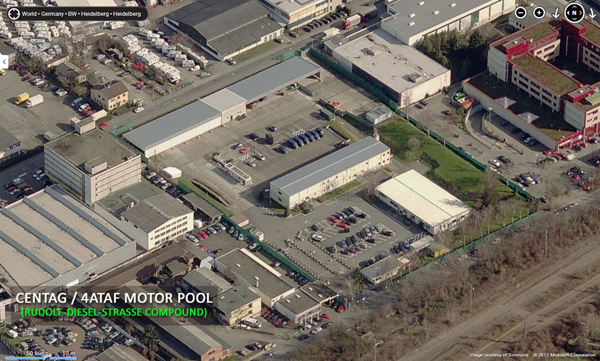 CENTAG/4ATAF Motor pool, Rudolf-Diesel-Strasse, Heidelberg (BING) (Click on image to see annotated hi-res aerial; click on BING to open BING Maps) |
|||||||||||||||||||||
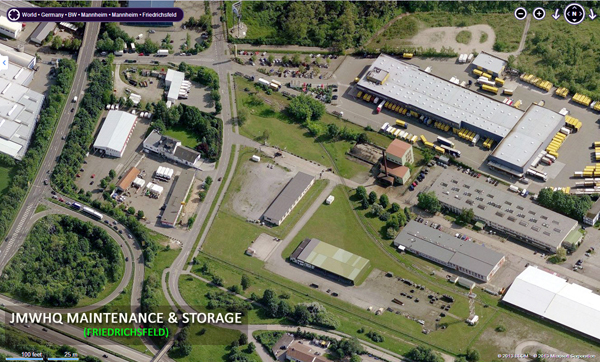 Joint Mobile War Headquarters Maintenance & Storgage Facility, Friedrichsfeld (BING) (Click on image to see annotated hi-res aerial; click on BING to open BING Maps) |
|||||||||||||||||||||
We, at the CENTAG / 4ATAF motor pool, trained the US crews how to drive German-type truck-trailer combinations on narrow German roads, especially back roads: Odenwald region, Pfälzer Wald region, Black Forest etc. GOOD TIMES! My job at CENTAG /4ATAF motor pool was Truck Squadron leader, instructor for driver training, and driver for trucks, buses, sedans etc.. Our team was bi-national, German-American, with mixed "In-Charge"-positions for the NCO ranks. We also trained Canadian and French soldiers, assigned to CENTAG / 4ATAF and some from HQ ACE Mobile Force AMF (NATO airborne). Our main task was to support HQ CENTAG / 4ATAF in all kinds of transportation questions - in garrison, in the field, on exercises and demonstrations etc.. In 1989 we assumed technical support of the Alternate Mobile War HQ, loaded on a huge number of Mercedes trucks and trailers, driven by soldiers of the various sections of HQ CENTAG / 4ATAF. The whole mobile HQ was independent when in the field. I have made lots of photos during this time. If you are interested, I can help. My main interest while in military was military fire fighting, especially fire trucks of the US AIR FORCE and US ARMY here in Europe. Thousands of photos have been shot. Almost everything is gone by now and history. Due to my job at HQ SHAPE /Belgium and later at HQ CENTAG in Heidelberg, I took the opportunity to take pictures of almost everything seen on the road, in garrison or in the field. But still not enough. |
|||||||||||||||||||||
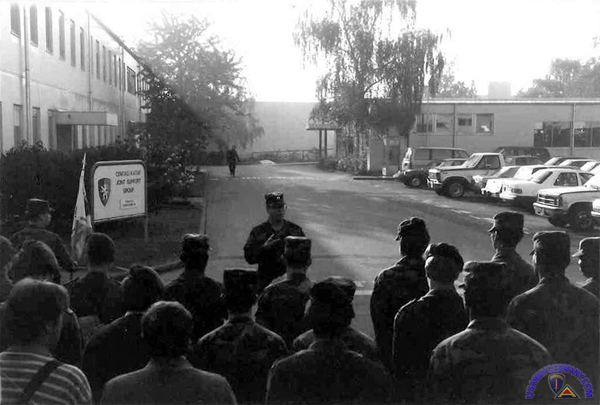 Formation next to Support Group headquarters building, Rudolf-Diesel-Strasse Compound |
|||||||||||||||||||||
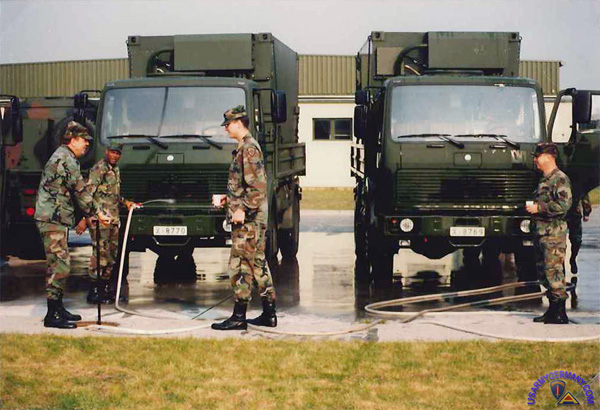 American troops assigned to HQ Support Group, Rudolf-Diesel-Strasse Compound |
|||||||||||||||||||||
| MoPo (the Motor pool), at the Rudolf-Diesel-Strasse Compound (later called International Hq Support Caserne), only housed the vehicles used with HQ CENTAG/4.ATAF in Heidelberg. Cars (sedans, station wagons, special staff cars), light trucks/vans/pickups, medium size trucks/vans, 5-ton size trucks for general purpose, the ambulance truck, the NBC truck, the maintenance truck and van plus recovery trailer, small/medium/large size buses. MP Mercedes `G` Wagon 4x4 patrol cars and the small number of vehicles used with the French and German Army elements. All other vehicles were "guests" only. The JWHQ vehicles and equipment was stored/parked at Friedrichsfeld facility. If needed, we could use the two heavy crane/recovery and fuel trucks, usually in use with the JWHQ. The JWHQ storage was its own compound inside the Friedrichfeld US QM facility. Fenced all around and having its own locked gate. But we had to pass the US main gate to get to ours. This storage cosists of a huge parking area for all the trucks (cargo, shelter, kitchen, office...), trailers (cargo, water tanker, power units), semi truck-trailer combinations, the two fuel tankers, the `Expando-Van` (US 5-ton type van trucks with folding sides) used as conference van or office and the two heavy crane/wrecker trucks (used for recovery and lifting shelters from and on trucks), if not parked at Rudolf-Diesel-Strasse compound. Service personnel came from our motor pool (really a quiet, relaxing job...!). CENTAG/4ATAF War HQ`s were Ruppertsweiler Underground Facility (called RUF) and Kindsbach Underground Facility (called KUF), first used by CENTAG (RUF) and 4.ATAF (KUF), later the two used by both (Joint HQ). Plus the Joint Mobile War HQ, based on trucks, trailers etc.. On exercises (24hrs. duty) we used both bunker facilities plus barracks in Pirmasens, Münchweiler, Ramstein, Sembach etc.. All assigned personnel were lodged at hotels, guesthouses, Arius Kaserne (at RUF), nearby US or German barracks or recreation parks close to RUF or KUF. |
|||||||||||||||||||||
|
|||||||||||||||||||||
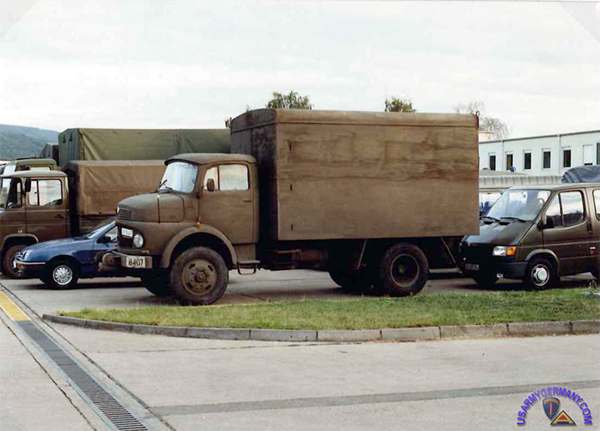 Vehicles of the 97th Sig Bn (US) at the Rudolf-Diesel-Strasse Compound |
|||||||||||||||||||||
|
|||||||||||||||||||||
| CENTAG Signal Group | |||||||||||||||||||||
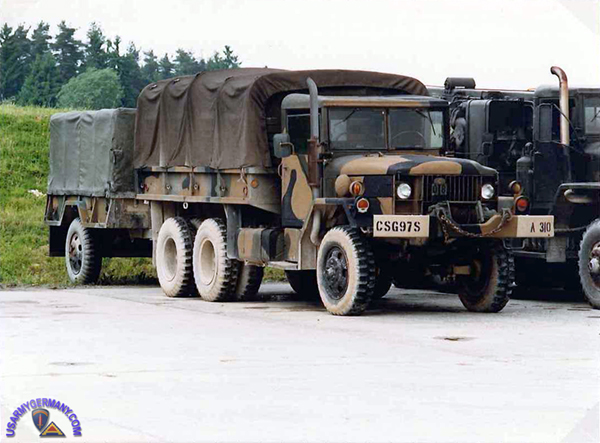 Vehicles of A Company, 97th Sig Bn at Grafenwoehr, 1987 (Benno Knorr) |
|||||||||||||||||||||
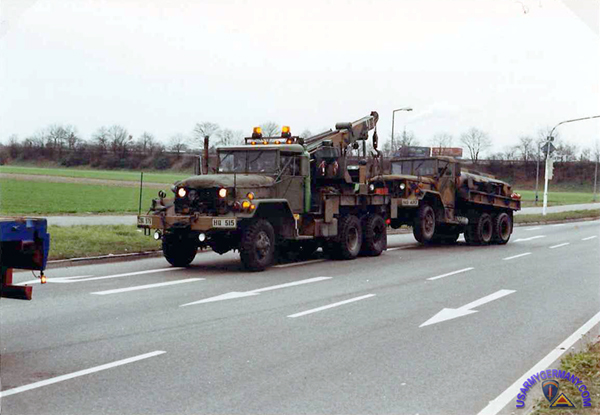 A 97th Sig Bn wrecker tows a tanker from the same unit near Sandhofen (Benno Knorr) |
|||||||||||||||||||||
| (Source: 97th Signal Battalion, 40 Years, 1952-1982) | |||||||||||||||||||||
| The CENTAG Signal Support Group was formed on 1 July 1969. However, its development actually began in April 1960, with the formation of CENTAG Signal Battalion (Provisional), consisting of two US Signal Companies, the 208th Signal Company and the 521st Signal Company. Later that year, in October, the 125th French Signal Company was assigned, establishing the unit as an international command in CENTAG (NATO). At this time, the name was changed to the CENTAG Signal Operations Battalion. The Battalion became tri-national on 2 May 1962, when the 75th German Signal Company was added, bringing the number of companies to four. In September 1966, a second German Signal Company, the 76th, was assigned as a replacement for the French Company which was reassigned. (1) Almost three years later, on 1 July 1969, the CENTAG Signal Operations Battalion was reorganized and redesignated as the CENTAG Signal Support Group. At that time the Group received operational command of the 97th (US) Signal Battalion and the German Signal Battalion (CENTAG). In January 1971, the Group headquarters became tri-national with the arrival of a Canadian Staff Officer. The final change during the Group's seventeen (17) year history was the redesignation of the German Battalion as the 890th (GE) Signal Battalion (Fernmeldebataillon 890) in April 1971. Today (1982), the CENTAG Signal Support Group, consisting of over 1600 officers and men, stands well trained and equipped to accomplish its vital mission of providing communications for the Commander, Central Army Group and his Staff. (1) I believe the 75th (FmKp 75) at Münchweiler became 4th Company, 890 GE Sig Bn when that battalion was formed in 1971.. |
|||||||||||||||||||||
| (Source: Email from Jack Atwell) | |||||||||||||||||||||
| I was stationed on the hill above the "cave" at Ruppertsweiler ( |
|||||||||||||||||||||
|
|||||||||||||||||||||
| 1970-80s | |||||||||||||||||||||
| (Source: Author's collection) | |||||||||||||||||||||
|
|||||||||||||||||||||
| Signal Operations Battalion | |||||||||||||||||||||
| (Source: Email from Howard Emery, 208th Sig Co, 1960-62) | |||||||||||||||||||||
I was looking on the web to find out when CENTAG was discontinued, when I came across your site. I was among the first personnel in the signal support for CENTAG, and it was an enjoyable assignment for me and my family.
While assigned to the 17th Signal Battalion in Germany, I received orders on 1 Jul 1960 along with 11 other enlisted men to attend a course of instruction in microwave radio relay equipment at the S.A.T. factory in Paris, France. Upon completion of the training we returned to our duty station until 11 Oct 1960, when I was re-assigned to the 208th Signal Support Company at the US Army Hospital at Munchweiler, Germany. On 9 Nov 1960, I received orders that changed the company's name to 208th USA Signal Company (Support). We were the initial personnel of the new company. I remained there until 8 Sep 1962, serving in the following positions: Training & Security NCOIC; Field testing of mobile microwave & radio relay equipment; Liaison & Translator NCO for the French Army. Our company had soldiers from the 1st French Army at Angevillers, France, Baden Baden Germany and at Hill 450 attached to it. Radio stations were at Hill 450 nearby and at Hill 555 near Bergzabern, Germany, the Com center was located below Hill 450 in a tunnel near Ruppertsweiler, Germany. The personnel working at hill 450 and the com center were billeted at the Army hospital and those at hill 555 lived on site. The tunnel that housed the Com center below Hill 450 was at one time part of the Sigfried Line fortifications and extended for many miles underground. Many of these tunnels housed our military Headquarters and com centers, both in Germany and in the Maginot line tunnels in France. You must be aware that the location of the wartime headquarters prior to CENTAG becoming a separate command was in an underground tunnel (built as part of the Siegfried Line) located in Ramstein, the town, not the Air Force Base (Webmaster note: this might have been Kindsbach). Kind of amusing for us NCOs that one had to be a Brig. Gen. or above to dine in the Officer's Mess in that tunnel. We were issued CENTAG ID cards with descriptions in English, French and German, and required new security clearances to comply with NATO and CENTAG. The CENTAG wartime headquarters I was referring to was in an underground tunnel (built as part of the Siegfried Line) located in Ramstein, the town, not the Air Force Base.
|
|||||||||||||||||||||
| ADDITIONAL INFORMATION: Q: After the 208th Sig Co was formed, was it attached to the 17th Sig Bn or did it report directly to CENTAG? A: No, the 208th was not attached to the 17th Sig Bn. The 17th was a field signal battalion that supplied communications for USAREUR during field exercises. It also provided communications for 4th ATAF exercises. The 208th was directly under CENTAG; German General Spidel was the CENTAG Commander at the time. Our Battalion was staffed with personnel of the three nations: USA, France and Germany. Q: Was the 208th a US signal unit with a few French soldiers attached orwas it an equal mix of US and French soldiers? A: The 208 had about 15 French soldiers attached to the company. Q: Was the 208th primarily a radio relay company? If so, did it connect the CENTAG wartime headquarters at Ruppertsweiler with the peacetime hqs in Heidelberg? A: Radio relay was a great part of the organization. However, Com center operations were a part as well. The connections were with Com centers in both France and Germany. The 208th radio net was far reaching. Hill 450 was both a terminal site and relay station. For certain I know that it reached the 1st French Army at Angevillers. The 208th had a couple of personnel at that location for a time. Whether the French had another relay at Bitche, France, I am not certain, but as the UHF was basically line of site (30-50 miles range depending on elevations) it would have been needed to have further relays. The equipment at Hill 450 had 24-voice channels and each of those channels was capable of 48 TTY units (teletype). Practically the net was much like a long distance telephone network. At Hill 555 which was a multiple relay station there was a link to CENTAG headquarters as well. No terminal equipment was at Hill 555, just radio relay on that system.
Q: Was there also a comm link between Ruppertsweiler and the Headquarters of 7th Army (Stuttgart) and 1st French Army (Baden-Baden)? If so, which unit operated that link? A: Yes, The 208th had 6 French soldiers attached to it that operated the link between Baden Baden and the 7th. The links from Baden Baden by the French were high frequency radio (morse code) nets. As I was the liaison NCO for the French team at Baden Baden, I can recall one amusing story. The French soldiers there had repeated complaints from some American operators about the 60 words per minutes peed that they sent code and it was kind of demoralizing them a bit. On one trip I brought along a fellow from my unit who was a railroad key operator in civilian life, he was capable of sending +120 wpm, I had him take over the key for the French soldier as he received the complaint again. There was never another complaint about their 60 wpm from the Americans as they could not copy the speed of the fellow I brought down there and since the US soldier on the other end did not know it was not the same French operator, the morale of that small group I had down there was much improved. Q: You mentioned going to a French factory for training. Did the 208th use French radio relay equipment? Exclusively? A: Our Mobile Microwave equipment was French, Generators were German, Towers were USA. The stations were mounted in French Saviom (sp?) trucks. However, most of our radio relay equipment was American VHF. The Mobile Microwave Stations on trucks for which I was responsible were field tested at different locations with repeated tower installations and field tested until we were able to relocate them and install them in a day's time. Their mission was to establish a multi-channel telecommunications system at new locations as required. Sadly, the only failure were the American built 66-foot towers that experienced metal fatique after repeated erection and 2 of them collapsed. However, the French Microwave systems and German generators performed flawlessly. After field testing those units were put in service on Hills 450, 555 and other locations I cannot remember to increase the volume of telecommunications capability for the net to Centag HQ. and be on the ready to move as required. All in all the 208th provided constant communications links 24 hours around the clock to the various headquarters. Some of these links were provided prior to the CENTAG organization by the 17th Signal Battalion, 175th Signal Service Company and the 102nd Signal Battalion. The mission of the 17th was more of a field (tactical) nature than that of providing permanent links. Remember, this was not a "radio net" such as high frequency HF (morse code and or voice), it was Very High Frequency VHF that sent out multiple information on one frequency and required multiplexing and demultiplexing terminals to extract the information. The VHF radio relays could not access any information being transmitted or received, only receive and pass on the signal.
Terminals would have the capability to access the information with their equipment and generally would have hardwired connections to com centers. This was much the same with microwave only at higher frequencies ( ultra high frequency UHF), generally with greater number of channels and at less powre output. Security wise even though the enemy mag intercept the radio signals the could not gain usable information unless they had the exact same multiplexing and demultiplexing equipment.
In order to help clear things up a bit about Angevillers, I have to go back to the mid-1950s when I was in the 102nd Sig Bn. I was assigned to three separate Stations in my company over the period of some years. A terminal station at Orleans (ORL callsign), a relay station at Fromont (FMT callsign), and a terminal station, Thionville (THE callsign) near Angevillers. At the latter station we were billeted by the French Army at Camp d' Angevillers and later by the 175th Sig Svc Co when they located at the French Army installation. The 175th installed a VHF Radio terminal station on the site of our station and also had personnel located in the French Army's huge communications center located in a Maginot Line Tunnel there at Camp d' Angevillers. This area was, to the best of my recollection, one of France's main Communication centers. The French soldiers attached with me in the 208th in later years were from that installation, even those I had in Baden Baden who operated a HF net at that location. Some of the French Officers and NCOs that I knew when assigned to the 102nd were the same ones I liaisoned with while in the 208th. I cannot say for certain how many relay stations may have been utilized between hill 450 and Angevillers, but they would more than likely have been operated by the French, perhaps at Camp Bitche or other locations. I have found no information on your site about the 175th Sig unit. I do not know what group they were under. With Microwave we had an order wire to communicate with the other stations that was not broadcasted, but an inegral part of the system. What I am trying to say is our transmissions were just a signal and if you had a receiver in the line of sight of it at the correct frequency you would have only heard a tone. I hope that this helps your understanding, some of the events are a bit hazy for this old mind in this day. |
|||||||||||||||||||||
| (Source: Email from Robert Plumadore ) | |||||||||||||||||||||
I was assigned to the 208th Signal Co from April 1962 until April 1964. I was assigned to the motor pool.
Everyone got along with only a few exceptions. It was probably the best two years of my almost 10 career.
Like Dan Shanks said - we gave up our US Military ID and were issued a CENTAG ID. Also our regular clerances were not honored we had to be recleared for NATO. The vehicles we had were mainly the worst of the worst, some had been salvaged, we did not have a unit tool set or a complete set of mechanic's hand tools. We did the best we could. The rest of the Army in Europe had the new Ford M151 (MUTT) 1/4 ton vehicle, we were stuck with the Korean war vintage M38, not the M38A1, but the old Willis of 1950. Dan mentions there were multi-national vehicles; the only ones were two French Renaults that would only run when coaxed by Al Trent, a country mechanic from Morristown, TN.
I only have contact with Albert Trent, Albert Neal and John Ketch from that old unit. |
|||||||||||||||||||||
| (Source: Email from Dan Shanks) | |||||||||||||||||||||
When I was assigned in 1963 the company was known as the 208th Signal Co. I believe in 1964, the company changed names to Company B, CENTAG. |
|||||||||||||||||||||
| (Source: Email from Bruce Fassett) | |||||||||||||||||||||
| I was assigned to the 521st Sig Op Co in February
1964. When I arrived it turned out to be Company A,
Sig Op Bn of CENTAG. I was there for a year. Can
probably dredge up some recollections from time spent
there. Is
there anyway to get a roster from that time period? I went back to Europe in May of 2000 and visited the old bunker. Well, I visited what was left of it. It was in the process of being demolished. |
|||||||||||||||||||||
| (Source: Email from Gregory Greek, Co B, CENTAG) | |||||||||||||||||||||
| I was assigned to Company B, HF platoon at Mannheim, Germany in early August 1966. My MOS was radio/teletype operator. We ran AN/GRC-26D's mounted on flatbed Mercedes trucks. (We used the ANGRY 26D's the entire time I was in Europe. They were our Army versions of a Winnebago.) Our home away from home away from home.) We were stationed at a little site in a residential area of the city. This was possibly the Feudenheim bunker. After about 6 months half of us were put on TDY duty at Company A in Muenchweiler at the field hospital. There were about 15 or so of us crammed in a little, maybe 12 or 13 feet square, room along with all our gear. After about 6 months or so we were moved again up on one of the mountaintop radio sites. We called it Tiger 20. It looked a lot like what is called Sig Op Site A. I didn't care too much for Army life but if I had been given the opportunity I belive I would have been more than happy to have spent a career in that area. It was absolutely beautiful. I would like to hear from anyone that had a similar experience. I can't get anyone to believe that any part of Army life was like that. I consider myself extremely lucky to have had that experience. |
|||||||||||||||||||||
| (Source: Email from Tom Holzer, Co A, Sig Op Bn, 1968-69) | |||||||||||||||||||||
I was with Co A, Sig Op Bn, CENTAG, Feudenheim Bunker, Mannheim from 1968 & 1969. The Feudenheim Bunker had a major switchboard and, as we understood it, computers related to the missile systems. We had NATO credentials and, as identified by others, did not have formations or inspections. This was a multi-national location.
We ran the wireless communications check between sites. We were the backup if the Land Lines failed. Our little radio room was the hangout for the lesser senior officers during alerts. It was not uncommon for full birds and 1 stars to join us in the radio room. This kept them away from the 2 & 3 stars running the show. Part way through my assignment, part of our group was moved to a remote location where we setup our radio link and our job was to keep connected 24 hours. We lived pretty much on the economy. One of the names I recall is Little. I believe he was the Sgt. in charge of that detail.
I got my Amateur Radio License when I was in Germany and operated a MARS station from the Bunker. I was sorry to hear that the bunker was torn down.
Part of the joy for me was our flexibility. We had passes whenever and since I could speak some German, my time there was wonderful. |
|||||||||||||||||||||
| MISCELLANEOUS CENTAG UNIT CRESTS | |||||||||||||||||||||
|
|||||||||||||||||||||
|
|
|||||||||||||||||||||
Related
Links
|
|||||||||||||||||||||
